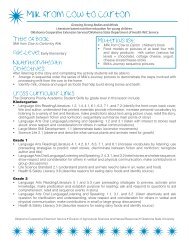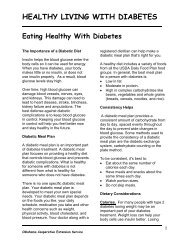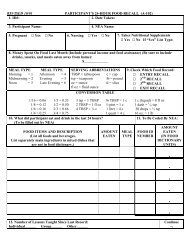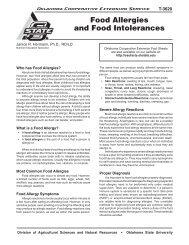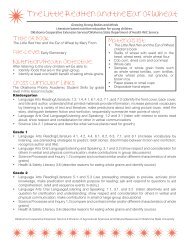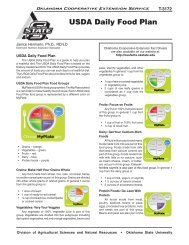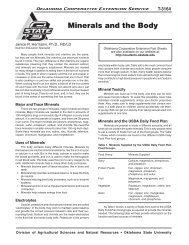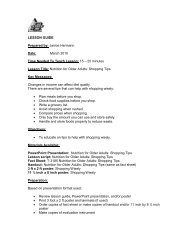Ethical Leadership IG Cover.indd - Family and Consumer Science ...
Ethical Leadership IG Cover.indd - Family and Consumer Science ...
Ethical Leadership IG Cover.indd - Family and Consumer Science ...
You also want an ePaper? Increase the reach of your titles
YUMPU automatically turns print PDFs into web optimized ePapers that Google loves.
DEVELOPING EFFECTIVE LEADERS16. <strong>Ethical</strong> Decision-Making Process• This process of examiningour behaviors- perceive, clarify,choose, act, reassess -can help us evaluate anethical dilemma moreobjectively.• Personal vs. Community—if your loyalty is stronger towardthe individual, then you wouldn’t tell what you know. If it isstronger toward the organization, then you would tell whatyou know.A Decision-Making Process(Slide 16)To behave ethically, it helps to closely examine behaviors <strong>and</strong>motives. People must perceive, clarify, choose, act, <strong>and</strong> reassesstheir behaviors based on ethical principles.Perceive - recognize the ethical implications of the situation.Clarify - identify the ethical values <strong>and</strong> principles of the stakeholdersin the situation17. <strong>Ethical</strong> Decision-Making ModelsIntroduce the models.• Personal WarningSystem• Bell, Book, <strong>and</strong> C<strong>and</strong>le• M.O.R.A.L.18. Personal WarningSystems• This model providesquestions to ask yourself.• The questions provideclues to what action youshould take.Select - develop each option in a best/worst case scenario <strong>and</strong>choose the option that does least harm <strong>and</strong> most good for the peopleinvolvedAct - take action on the selected optionReassess - evaluate the decision making <strong>and</strong> action <strong>and</strong> developguidelines to avoid similar dilemmas in the futureThis process can help us move beyond our internal value systems tocreate a fresh objective approach to an ethical dilemma.<strong>Ethical</strong> Decision-Making Models(Slide 17)As we become more conscious of everyday ethical behavior, there areseveral models to which we can refer for a more objective approachto ethical decision making.How can we transform an ethical dilemma into a course of action?Decision making models help people look at ethical problemsobjectively. Three models are included here: Personal WarningSystems; the Bell, Book, <strong>and</strong> C<strong>and</strong>le Test; <strong>and</strong> the MORAL model.Several more complex models can be found in other literature. Thesemodels provide a framework <strong>and</strong> process to use when making ethicaldecisions.Personal Warning System (Josephson Institute of Ethics)(Slide 18)Ask yourself these questions. Your answer will provide clues to yourcourse of action.• Kid on your shoulder: Would you be comfortable if yourchildren were watching you; are you setting the example youwant them to follow?ETHICAL LEADERSHIP - MODULE OUTLINE 9



